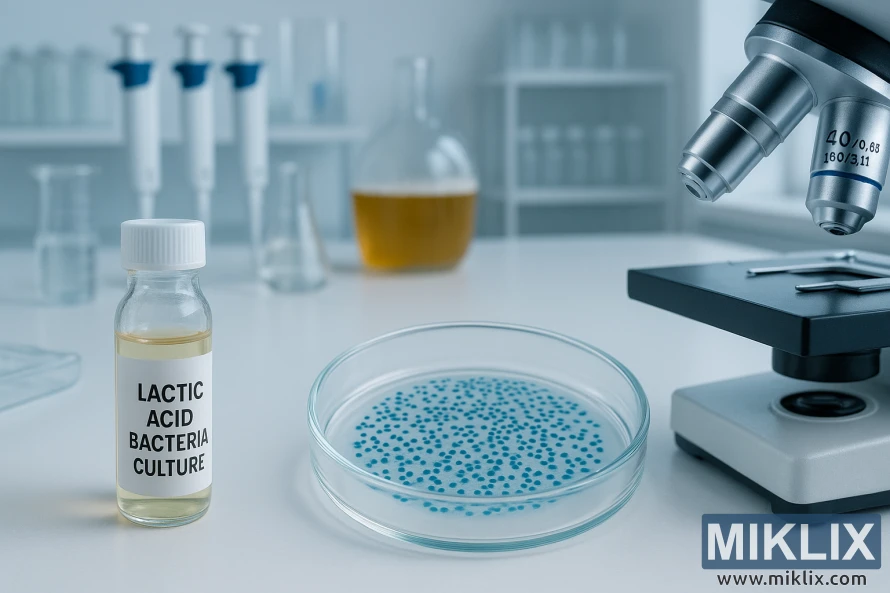Image: Lactic Acid Bacteria Lab Setup
Published: September 15, 2025 at 7:14:16 PM UTC
A clean lab scene showing a labeled vial of lactic acid bacteria culture, a Petri dish with blue colonies, and a microscope on a white benchtop.
The image presents a carefully composed and highly detailed scene set within a professional microbiology laboratory, designed to visually communicate the process and precision involved in studying Lactic acid bacteria cultures used in sour beer fermentation. The overall atmosphere is clean, bright, and organized, with a slightly cool color temperature that reinforces the sense of clinical accuracy and scientific rigor. Every element in the scene appears deliberately placed to highlight the analytical nature of the work being conducted.
In the immediate foreground, which dominates the viewer’s focus, sit two key objects: a small, clear glass vial and a shallow Petri dish. The vial is cylindrical and sealed with a white screw cap, filled about halfway with a pale yellow, slightly translucent liquid. A crisp white label on the vial bears the bold black text “LACTIC ACID BACTERIA CULTURE,” clearly indicating its contents. The vial’s glass surface catches the bright laboratory lighting in sharp highlights along its edges, emphasizing its cleanliness and sterile condition. Tiny light reflections glimmer off the meniscus of the liquid inside, suggesting careful handling and precision measurement.
Beside the vial, slightly lower and flatter against the white benchtop, is the Petri dish. It is made of clear glass or high-grade transparent plastic, with perfectly smooth, circular edges that catch soft rings of reflected light. Within it, spread across the nutrient agar medium, are numerous evenly dispersed colonies of bacteria. They are stained a vivid blue, appearing as dozens of small, round dots varying subtly in size. The dots are arranged in a pattern that suggests cultured growth from individual colonies, demonstrating the thriving propagation of the lactic acid bacteria. The sharp focus on the Petri dish allows the viewer to appreciate both the fine granularity of the bacterial clusters and the flawless clarity of the dish itself, which rests flatly on the spotless work surface.
To the right, partially overlapping the foreground but slightly receding into the middle ground, stands a compound microscope. Its base is sturdy and matte black, while its metal body gleams softly under the even lighting. The objective lens assembly is angled toward the Petri dish, visually suggesting active examination of the bacterial colonies. Fine engraved markings on the lens casing, including magnification specifications, are clearly legible, reinforcing the scientific precision of the setting. The microscope’s presence symbolically connects the visual bacterial colonies in the dish with the unseen microscopic cellular detail they represent.
In the slightly blurred middle ground are additional pieces of standard laboratory glassware and tools that contribute contextual authenticity without distracting from the primary focus. A set of pipettes with blue tops stand vertically in a rack, their slender shafts catching thin streaks of light. Next to them are various glass beakers and graduated cylinders, their transparency merging softly into the background’s cool tones. A spherical glass fermentation vessel containing a warm amber liquid provides a subtle visual counterpoint to the otherwise cool color palette, hinting at the application of these bacterial cultures in brewing. These items are neatly arranged and free of clutter, conveying efficiency and order.
The background completes the composition with the wider laboratory environment: bright white shelving holds rows of additional glassware, culture flasks, and sterile containers, all symmetrically organized. The lighting is bright yet diffuse, eliminating harsh shadows and bathing the space in a clean, almost clinical glow. Cool bluish undertones dominate the color temperature, emphasizing sterility and scientific rigor while also enhancing the visibility of the blue-stained bacterial colonies in the Petri dish. The walls and shelving are white or very light gray, further reflecting and diffusing the light to maintain visual clarity.
Altogether, the photograph conveys a scene of disciplined, methodical scientific investigation. It balances sharp focus in the foreground—where the lactic acid bacteria culture is shown both as a liquid sample and as visible colonies—with a gradual softening of detail toward the background, which frames the work in its proper laboratory context. The composition, lighting, and choice of objects all combine to highlight the technical and analytical care involved in evaluating and preserving these specialized brewing cultures, portraying them as both scientifically significant and meticulously handled.
The image is related to: Fermenting Beer with Fermentis SafSour LP 652 Bacteria

